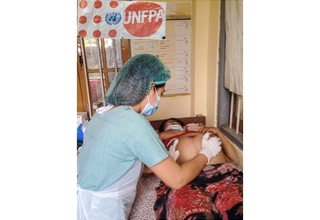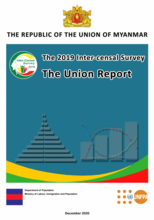YANGON, Myanmar — A new census report reveals that poverty and disability in Myanmar are intertwined in a vicious circle where both factors reinforce each other. There are twice as many people with disability in the poorest 20 percent of the population compared to the richest 20 percent.
The findings come from the 2014 Myanmar Population and Housing Census Thematic Report on Disability, published by the Ministry of Labour, Immigration and Population and UNFPA. The report shows that many of those living with a disability cannot access education, employment and health services: They are trapped in poverty and exclusion from everyday life activities. The report underscores the need for disability-inclusive policymaking, which improves the quality of life and which promotes the human rights of disabled people.
Children with disabilities are often excluded from the formal education system, placing them at a double disadvantage from the start of their lives. In Myanmar, 44 per cent of moderately disabled 13 year olds have never attended school, compared to 4 per cent of 13 year olds with no disability. For 15-19 year olds, Illiteracy levels among the disabled are more than 10 times as high (59.4 per cent) as for those without disabilities (5.6 per cent), adding an additional and lifelong handicap to their disadvantages.
The lack of education leads to fewer employment opportunities. The census shows a lower labour force participation rate for people with disabilities, women in particular, revealing a gender gap that places women in a more disadvantageous position.
“Women and girls with disabilities often face double discrimination. This puts women with disabilities at a higher risk of marginalisation and discrimination, gender-based violence, sexual abuse, neglect and exploitation. This restricts their ability to attain their full potential, to contribute to society, and to enjoy their rights as any other human being does“, says Janet Jackson, UNFPA Representative for Myanmar.
“The economic participation of people with disabilities will contribute to Myanmar’s development. To enable them to do so, the Government needs to provide high-quality education to children and young people with disabilities in an inclusive environment. One important aspect of this is improved wheelchair access for those who are unable to walk“, adds Jackson.
The report shows that households with a disabled family member have less access to motorized transport, electricity, modern communications, clean water and toilets, again revealing the link between disability and poverty. One in six people with disabilities have no access to a toilet at all.
More than half of all people with disabilities live in extended households, and only a small minority live in institutions. This shows that the care of people with disabilities rests very much in the hands of relatives, underscoring the need for improved social support systems.
In Myanmar, as well as globally, disability increases dramatically with old age. With an ageing population, Myanmar will see a significant increase in the number of people with disabilities in the next 35 years.
“Policies and programmes which aim to improve the living conditions of people with disabilities need to take into account their increase in numbers over time. Older people with disabilities have specific needs and will require dedicated care“, says Janet Jackson, UNFPA Representative for Myanmar.
Because there are more older women than men, the absolute number of older women with disabilities is considerably higher than that of older men. There is also considerable variations in the prevalence of disability across the country. People living in rural areas have higher levels of disability compared to their urban counterparts.
According to the report, people with disabilities are less likely to get married, and for those who do marry, the chances of the marriage dissolving is twice as high compared to people who have no disability. Many of those whose marriages have been dissolved live alone and are at higher risk of isolation and social and economic hardship.
In the census, 4.6 per cent of the population were reported to have disabilities. The data collected serves primarily to draw a clearer picture of the living conditions of people with disabilities in Myanmar. The report provides the first nationally representative analysis where the situation of people with disabilities is compared to their peers without disability.
Download: 2014 Myanmar Population and Housing Census: Thematic reports
***
For more information, please contact:
Yenny Gamming; Tel: +95- (0)9 2604 00005; gamming@unfpa.org
Si Thu Soe Moe; Tel: +95- (0)9 4500 57730; soemoe@unfpa.org
UNFPA, the United Nations Population Fund, delivers a world where every pregnancy is wanted, every childbirth is safe and every young person’s potential is fulfilled.
Notes to editors
The census project
The main results of the 2014 Myanmar Population and Housing Census were published in May 2015. This thematic report is part of a series of thematic reports on diverse topics. The thematic reports contain new data as well as previously released data which have been statistically adjusted for higher accuracy. The reports analyse the relationship between different data, and shed light on what the numbers tell us about the lives of people in Myanmar. The census was conducted by the Government of Myanmar. UNFPA has provided, and continues to provide, technical and financial support towards the census.
Non-enumeration
An estimated 1,090,000 people who wished to self-identify as Rohingya were not enumerated in the census. UNFPA recognizes their non-enumeration as a serious shortcoming of the census and a grave human rights concern, and regards it as critical that all rights are restored as soon as possible. An estimated 69,700 people in Kayin State and 46,600 people in Kachin State were also not enumerated. In total, an estimated 1.2 million people were not enumerated in the census. These estimated 1.2 million people were included in the total population count of 51.5 million. However, since data on characteristics is not available for the people who were not enumerated, the data and analysis presented in this report covers only those enumerated during the census.
Online census library
Census reports can be accessed on the UNFPA website or on the Department of Population website.




